
Mantua is a city and comune in Lombardy, Italy, and capital of the province of the same name.
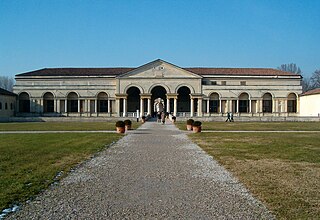
Palazzo del Te or Palazzo Te is a palace in the suburbs of Mantua, Italy. It is a fine example of the mannerist style of architecture, and the acknowledged masterpiece of Giulio Romano. Although formed in Italian, the usual name in English of Palazzo del Te is not that now used by Italians. The official modern name, and by far the most common name in Italian, is Palazzo Te. The English name arises because the art historian, Vasari, calls it the "Palazzo Del T", and English-speaking writers, especially art historians, still most often call it "Palazzo del Te".
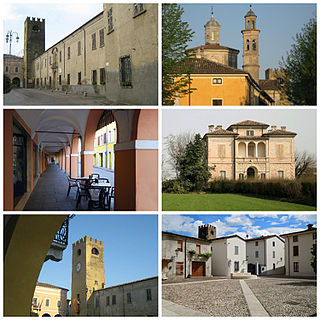
Castel GoffredoItalian pronunciation: [kaˈstɛl ɡofˈfreːdo] is a comune in the province of Mantua, in Lombardy, northern Italy, 35 kilometres (22 mi) from Mantua and a few more from Brescia. It lies in a region of springs at the foot of the slopes that drain into Lake Garda, towards the plain of the Po. Castel Goffredo borders the following municipalities: Castiglione delle Stiviere, Medole, Ceresara, Casaloldo, Asola, Acquafredda, Carpenedolo.

Lorenzo Leonbruno, also known as Lorenzo de Leombeni, was an Italian painter during the early Renaissance period. He was born in Mantua (Mantova), an Italian commune in Lombardy, Italy. Leonbruno is most well known for being commissioned by the court of Francesco Gonzaga, Marquis of Mantua, and his wife Isabella d'Este. The patronage continued with their eldest son Federico II Gonzaga, who was the fifth Marquis of Mantua. Leonbruno was the court painter for the Gonzaga family from 1506–24.
Gasparo Antonio Turbini was an Italian architect and Jesuit priest, mainly active in a Neoclassical-style in the Province of Brescia, Italy.
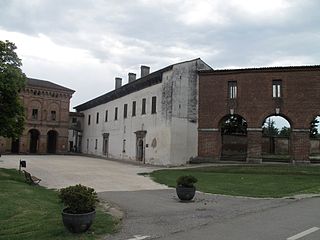
The Galleria degli Antichi and the Palazzo del Giardino are adjacent, contemporaneous, Renaissance-style buildings located on Piazza d`Armi #1 in Sabbioneta, in the Province of Mantua, region of Lombardy, Italy. Prior to 1797, the buildings were connected to the Rocca or Castle of Sabbioneta, and the gallery once housed the Gonzaga collection of antique Roman statuary and hunting trophies. While the architectural design of the gallery is striking, the richness of the interior decoration of the palazzo is also dazzling.

The Palazzo San Sebastiano is a 16th-century palace in Mantua. Built by the Gonzaga family, since 19 March 2005 it has housed Mantua's city museum.
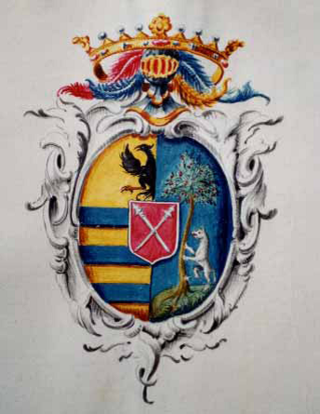
Paride da Ceresara was an Italian humanist, poet, alchemist and astrologer.

Aloisio Gonzaga was an Italian condottiero.
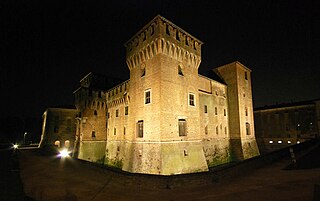
The Castello di San Giorgio is part of the Ducal palace of Mantua. It is a moated rectangular castle, each of which's four corners has a large tower and the moat is crossed by three drawbridges.

Castel Goffredo Town Hall and Loggia della Magnifica Comunità are located in Piazza Mazzini in Castel Goffredo, in the Province of Mantua (Italy). It is the seat of the municipality.
Events in the history of Castel Goffredo, in Italy.
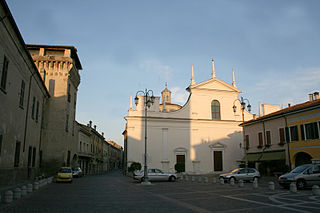
Piazza Mazzini is a public square in the center of Castel Goffredo, region of Lombardy, Italy.

Castelvecchio is the ancient fortified village of Castel Goffredo, in the province of Mantua Lombardy region in Italy, surrounded by walls and a moat. The boundaries currently correspond to the garden of the Palazzo Gonzaga-Acerbi to the north, to vicolo Remoto and vicolo Cannone to the east, to Piazza Mazzini to the south and to piazzetta Castelvecchio and vicolo Castelvecchio to the west.

The Civic Tower is a historic building in the town of Castel Goffredo, in the province of Mantua, Italy.

The Torre dell'Orologio is a 15th-century renaissance tower on the Piazza delle Erbe in Mantua, Italy. It is attached to the Palazzo della Ragione, and next to the Rotonda di San Lorenzo. It houses an astronomical clock.
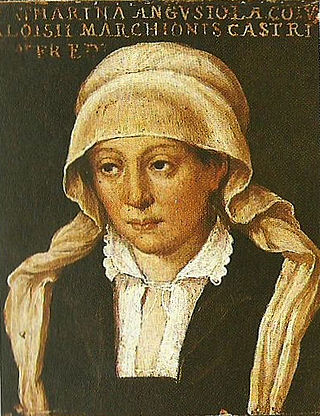
Caterina Anguissola Trivulzio was an Italian noblewoman.
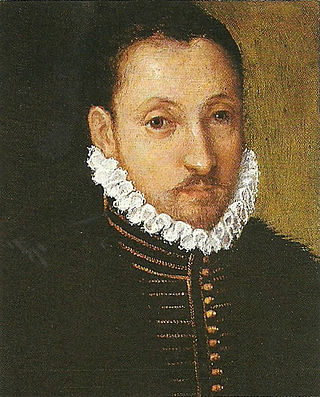
Ferrante or Ferdinando Gonzaga, first marquess of Castiglione was an Italian nobleman and condottiero.
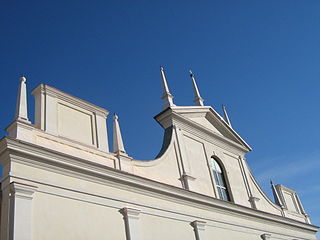
Sant'Erasmo is a Roman Catholic church located in Castel Goffredo, region of Lombardy, Italy.
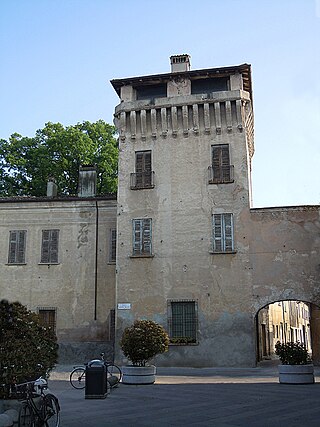
The Torrazzo is a historic building in Castel Goffredo, in the province of Mantua.



















